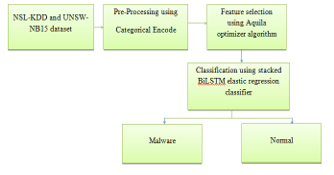Network Intrusion Detection Method Using Stacked BILSTM Elastic Regression Classifier with Aquila Optimizer Algorithm for Internet of Things (IoT)
Main Article Content
Abstract
Globally, over the past ten years, computer networks and Internet of Things (IoT) networks have grown significantly due to the increasing amount of data that has been collected, ranging from zettabytes to petabytes. As a result, as the network has expanded, security problems have also emerged. The large data sets involved in these types of attacks can make detection difficult. The developing networks are being used for a multitude of sophisticated purposes, such as smart homes, cities, grids, gadgets, and objects, as well as e-commerce, e-banking, and e-government. As a result of the development of numerous intrusion detection systems (IDS), computer networks are now protected from security and privacy threats. Data confidentiality, integrity, and availability will suffer if IDS prevention efforts fail. Complex attacks can't be handled by traditional methods. There has been a growing interest in advanced deep learning techniques for detecting intrusions and identifying abnormal behavior in networks. This research aims to propose a novel network namely stacked BiLSTM elastic regression classifier (Stack_BiLSTM-ERC) with Aquila optimizer algorithm for feature selection. This optimization method computes use of a cutting-edge transition function that enables it to be transformed into a binary form of the Aquila optimizer. A better solution could be secured once number of possible solutions are found from diverse regions of the search space utilizing the Aquila optimizer method. NSL-KDD and UNSW-NB15 are two datasets that enable learning characteristics from the raw data in order to detect harmful prerequisites characteristics and effective framework patterns. The proposed Stack_BiLSTM-ERC achieves 98.l3% of accuracy, 95.1% of precision, 94.3% of recall and 95.4 of F1-score for NSL-KDD dataset. Moreover, 98.6% of accuracy, 97.2% of precision, 98.5 of recall and 97.5% of F1-score.
Article Details
References
J. King & AI Awad, (2016) “A distributed security mechanism for resource-constrained IoT devices” , Informatica (Slovenia) Vol. 40, No.1 pp.133–143
M Weber & M Boban (2016) “Security challenges of the internet of things”, 2016 39th International Convention on Information and Communication Technology, Electronics and Microelectronics (MIPRO). IEEE, pp 638–643.
A. Gendreau & M. Moorman, (2016) “Survey of Intrusion Detection Systems towards an End-to-End Secure Internet of Things," 2016 IEEE 4th International Conference on Future Internet of Things and Cloud (FiCloud), pp. 84-90.
VP. Kafle, Y Fukushima & H Harai, (2016) “Internet of things standardization in ITU and prospective networking technologies”, IEEE Communications Magazine, Vol. 54, No.9, pp.43–49.
A Zanella, N Bui, A Castellani, L Vangelista & M Zorzi (2014) “Internet of things for smart cities”, IEEE Internet Things Journal, Vol.1, No.1, pp.22–32.
R Minerva, A Biru & D Rotondi, (2015) “Towards a definition of the internet of things (IoT)-Technical report” , IEEE Internet of Things.
C Han, JM Jornet, E Fadel & IF Akyildiz, (2013) “A cross-layer communication module for the internet of things”, Computer Networks, Vol.57, No.3, pp.622–633.
G.Kim, S. Lee & S.Kim, (2014) “A novel hybrid intrusion detection method integrating anomaly detection with misuse detection”, Expert System Applications, Vol. 41, pp.1690–1700.
K.Alissa, F.S. Alrayes, K.Tarmissi, A.Yafoz, R.Alsini, O.Alghushairy, & A. Motwakel, (2022) “Planet Optimization with Deep Convolutional Neural Network for Lightweight Intrusion Detection in Resource-Constrained IoT Networks”, Applied Sciences, Vol.12, No.17, pp.8676.
H.Han, H.Kim & Y. Kim, (2022) “Correlation between Deep Neural Network Hidden Layer and Intrusion Detection Performance in IoT Intrusion Detection System”, Symmetry, Vol.14, No.10, pp.2077.
S.Ullah, J.Ahmad, M. A.Khan, E. H. Alkhammash, M.Hadjouni, Y. Y. Ghadi, & N. Pitropakis, (2022) “A New Intrusion Detection System for the Internet of Things via Deep Convolutional Neural Network and Feature Engineering”, Sensors, Vol.22, No.10, pp.3607.
X.Kan, Y.Fan, Z.Fang, L.Cao, N. N. Xiong, D.Yang & X. Li, (2021) “A novel IoT network intrusion detection approach based on adaptive particle swarm optimization convolutional neural network”, Information Sciences, Vol. 568, pp.147-162.
M.Ramaiah, V.Chandrasekaran, V.Ravi & N. Kumar, (2021) “An intrusion detection system using optimized deep neural network architecture”, Transactions on Emerging Telecommunications Technologies, Vol.32, No.4, pp.e4221.
S.Alqahtani, (2022) “FSO-LSTM IDS: hybrid optimized and ensembled deep-learning network-based intrusion detection system for smart networks”, The Journal of Supercomputing, Vol.78, No.7, pp.9438-9455.
A.Fatani, A.Dahou, M. A. Al-Qaness, S. Lu & M. A.Elaziz, (2021) “Advanced feature extraction and selection approach using deep learning and Aquila optimizer for IoT intrusion detection system”, Sensors, Vol.22, No.1, pp.140.
Y.Li, S.M.Ghoreishi & A.Issakhov, (2021) “Improving the Accuracy of Network Intrusion Detection System in Medical IoT Systems through Butterfly Optimization Algorithm”, Wireless Personal Communications, pp.1-19.
Yang, Y. Zhuansun, C.Liu, J. Li, & C. Zhang, (2019) “Design of intrusion detection system for internet of things based on improved BP neural network”, IEEE Access, Vol.7, pp.106043-106052.
Y.Zhang, P.Li & X.Wang, (2019) “Intrusion detection for IoT based on improved genetic algorithm and deep belief network”, IEEE Access, Vol. 7, pp.31711-31722.
A.Fatani, M.Abd Elaziz, A.Dahou, M. A. Al-Qaness & S.Lu, (2021) “IoT intrusion detection system using deep learning and enhanced transient search optimization”, IEEE Access, Vol.9, pp.123448-123464.
R. A.Disha & S.Waheed, (2021) “A Comparative study of machine learning models for Network Intrusion Detection System using UNSW-NB 15 dataset”, In 2021 International Conference on Electronics, Communications and Information Technology (ICECIT) pp. 1-5.
R. D.Ravipati, & M. Abualkibash, (2019) “Intrusion detection system classification using different machine learning algorithms on KDD-99 and NSL-KDD datasets-a review paper”, International Journal of Computer Science & Information Technology (IJCSIT), Vol.11, No.3.

